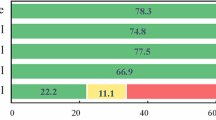Abstract
Individuals have a wide range of resources when searching for health topics. The aim of this research was twofold: (1) to identify and assess the resources college students use when exercising health information seeking behavior (HISB); and (2) to examine perceptions and behaviors regarding adoption of online tools. A questionnaire was developed to assess HISB in a sample of college students. Items pertaining to HISB were adapted from a Health Information National Trends Survey with permission from the National Cancer Institute at the National Institutes of Health. During Spring 2018, 258 students in 9 sections of a personal health class at a public university in NJ completed the questionnaire. Students were most likely to often or always use the Internet for health information (n = 74%) over other sources. Females were more likely to use the Internet for health information (p = .030), to consult a health or medical professional (p = .042) and to confirm the health information they find with a health or medical professional (p = .028). Females also reported spending significantly more time on social media (mean 4.96 h/day) compared to males (4.00 h/day, p = .041). Non-white students were significantly more likely to often use the Internet to find health information (p = .039), while white students reported spending significantly less time on the Internet (p < .001) and on social media (p < .001). Future research is needed to understand motivating factors for HISB, and to tailor interventions accordingly to assure that college students who exhibit HISB have appropriate levels of e-health literacy.
Similar content being viewed by others
References
Mukherjee, A., & Bawden, D. (2012). Health information seeking in the information society. Health Information and Library Journal, 29(3), 242–246. https://doi.org/10.1111/j.1471-1842.2012.00997.x.
Pesälä, S., Virtanen, M. J., Sane, J., Mustonen, P., Kaila, M., & Helve, O. (2017). Health information-seeking patterns of the general public and indications for disease surveillance: Register-based study using lyme disease. JMIR Public Health and Surveillance, 3(4), e86. https://doi.org/10.2196/publichealth.8306.
Chaudhuri, S., Le, T., White, C., Thompson, H., & Demiris, G. (2013). Examining health information–seeking behaviors of older adults. Computers, Informatics, Nursing: CIN, 31(11), 547–553. https://doi.org/10.1097/01.NCN.0000432131.92020.42.
Bratucu, R., Gheorghe, I., Purcarea, R., Gheorghe, C., Popa Velea, O., & Purcarea, V. (2014). Cause and effect: The linkage between the health information seeking behavior and the online environment-—A review. Journal of Medicine and Life, 7(3), 310–316.
Chen, Y., Li, C., Liang, J., & Tsai, C. (2018). Health information obtained from the internet and changes in medical decision making: Questionnaire Development and Cross-Sectional Survey. Journal of Medical Internet Research, 20(2), e47. https://doi.org/10.2196/jmir.9370.
Internet World Stats. (2017). Internet users in the world by regions. Retrieved from http://www.internetworldstats.com/stats.htm.
Social network users worldwide from 2010 to 2021 (in billions). Retrieved from https://www.statista.com/statistics/278414/number-of-worldwide-social-network-users/.
Bhandari, N., Shi, Y., & Jung, K. (2014). Seeking health information online: Does limited healthcare access matter? Journal of the American Medical Informatics Association: JAMIA, 21(6), 1113–1117. https://doi.org/10.1136/amiajnl-2013-002350.
Fergie, G., Hilton, S., & Hunt, K. (2016). Young adults’ experiences of seeking online information about diabetes and mental health in the age of social media. Health Expectations: An International Journal of Public Participation in Health Care and Health Policy, 19(6), 1324–1335. https://doi.org/10.1111/hex.12430.
Health Information National Trends Survey (HINTS). (2017). HINTS 5, cycle 1 survey. Retrieved from https://hints.cancer.gov/docs/Instruments/HINTS5_Cycle1_Annotated_Instrument_English.pdf.
Fergie, G., Hunt, K., & Hilton, S. (2013). What young people want from health-related online resources: A focus group study. Journal of Youth Studies, 16(5), 579–596. https://doi.org/10.1080/13676261.2012.744811.
Norman, C. D., & Skinner, H. A. (2006). eHEALS: The eHealth Literacy Scale. Journal of Medical Internet Research, 8(4), e27. https://doi.org/10.2196/jmir.8.4.e27.
Britt, R. K., Collins, W. B., Wilson, K., Linnemeier, G., & Englebert, A. M. (2017). eHealth literacy and health behaviors affecting modern college students: A pilot study of issues identified by the American College Health Association. Journal of Medical Internet Research, 19(12), e392. https://doi.org/10.2196/jmir.3100.
Pew Research Center. (n.d.). Teen and Young Adult Internet Use. Retrieved from http://www.pewresearch.org/millennials/teen-internet-use-graphic/.
Jackson, D. N., Chou, W.-Y. S., Coa, K. I., Oh, A., & Hesse, B. (2016). Implications of social media use on health information technology engagement: Data from HINTS 4 cycle 3. Translational Behavioral Medicine, 6(4), 566–576. https://doi.org/10.1007/s13142-016-0437-1.
Iftikhar, R., & Abaalkhail, B. (2017). Health-seeking influence reflected by online health-related messages received on social media: Cross-sectional survey. Journal of Medical Internet Research, 19(11), e382. https://doi.org/10.2196/jmir.5989.
Hogue, M.-C. B., Doran, E., & Henry, D. A. (2012). A prompt to the web: The media and health information seeking behaviour. PLoS ONE, 7(4), e34314. https://doi.org/10.1371/journal.pone.0034314.
Leung, L. (2008). Internet embeddedness: Links with online health information seeking, expectancy value/quality of health information websites, and internet usage patterns. Cyber Psychology & Behaviour, 11(5), 565–569.
Lewis, T. (2006). Seeking health information on the internet: Lifestyle choice or bad attack of cyberchondria? Media Culture and Society, 28(4), 521.
Tennant, B., Stellefson, M., Dodd, V., Chaney, B., Chaney, D., Paige, S., et al. (2015). eHealth literacy and web 2.0 health information seeking behaviors among baby boomers and older adults. Journal of Medical Internet Research, 17(3), e70. https://doi.org/10.2196/jmir.3992.
Author information
Authors and Affiliations
Corresponding author
Ethics declarations
Conflict of interest
The authors declare no conflicts of interest.
Rights and permissions
About this article
Cite this article
Basch, C.H., MacLean, S.A., Romero, RA. et al. Health Information Seeking Behavior Among College Students. J Community Health 43, 1094–1099 (2018). https://doi.org/10.1007/s10900-018-0526-9
Published:
Issue Date:
DOI: https://doi.org/10.1007/s10900-018-0526-9




